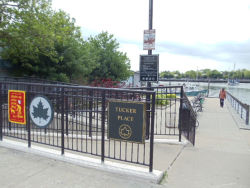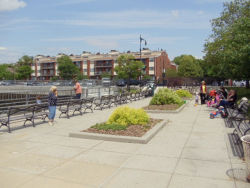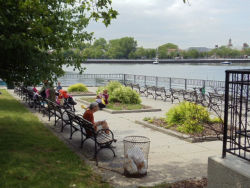Tucker Place
Driscoll Tucker Place
This site is named for J. Driscoll Tucker (1872-1945), a Brooklyn politician known as the “Mayor of Sheepshead Bay.” Tucker headed the Second Assembly District of Sheepshead Bay and worked to build the footbridge between Sheepshead Bay and Manhattan Beach.
The son of Irish immigrants John and Annie O’Driscoll, he was born on July 16, 1872 on East 41st Street in Manhattan, in the area now known as Tudor City. He grew up in the Sheepshead Bay area and took to a career in politics. Among his notable associations, Mr. Tucker worked as a secretary for Grover A. Whalen (1886-1962), a notable public official, who at that time held the office of Commissioner of Plant and Structures.
Tucker earned his nickname “Mayor” one night at the local Hotel Belmont Bar. There, his friends joked that if a man bought one round of drinks he was running for Alderman and if he bought two rounds he was running for State Senator. When Tucker bought an unprecedented three rounds of drinks, the men concluded that Tucker must be running for Mayor of Sheepshead. The name stuck. “Mayor” Tucker retired in 1934 and died of a heart condition January 19, 1945. He is buried in Calvary Cemetery in Queens.
Sheepshead Bay is the largest fishing community in Brooklyn. One of the latest sections of Brooklyn to be settled by Europeans, Canarsee Indians inhabited the area until almost 1790. In the Bay’s first few years of European inhabitance, notable families in the area included the Wyckoffs and Lotts. The crisp summer breezes and impressive shorefront drew many to the area in the early 19th century, and waterfront cottages emerged. The late 19th Century saw the establishment of the famous Sheepshead Bay Racetrack, bound by Gravesend Neck Road, Ocean Avenue, Knapp Street, and Jerome Avenue. The track drew the most famous horses and wealthy racing aficionados to its grounds. The racetrack later served as the runway for the first attempted transatlantic flight, performed by Calbraith P. Rodgers in 1911. It was torn down in 1923.
Throughout the 20th century, Sheepshead Bay experienced steadily rising population, holding the record for fastest growing community in Brooklyn during the 1960s. The ships docked in the Bay provide one of the area’s largest attractions, fresh seafood. The most famous eatery in the area, Lundy’s, on Emmons Avenue, would feed 2,800 patrons daily in its heyday. After closing its doors in 1979, the restaurant, now a New York City landmark, reopened in 1995.
Driscoll Tucker Place, an extension of East 27th Street built atop (now out of use) sewer pipes, was transferred to Parks in 1953. The City Council named this space in honor of J. Driscoll Tucker in 1954. In 1997, the park, located at East 27th Street and Emmons Avenue, was made handicap-accessible with $46,000 in funding from City Council Member Anthony D. Weiner. In 2001, Driscoll Tucker Place was renovated with $45,974 in funding from Mayor Giuliani, adding a new bed of concrete along with new planters. The parkland contains two acorn-style lamposts as well as a drinking fountain and World’s Fair benches. Two red maple trees (Acer rubrum) line the area along with shrubs including sand cherry (Prunus pumila), shore juniper (Juniperus Conferta), and blue spirea (Caryopteris xclandonensis). Many different perennials also line the space near the wall including ribbon grass (Phalaris arundinacea picta), yarrow (Asarum spp.), bugleweed (Ajuga reptans), and lilyturf (Liriope).
Check out your park's Vital Signs
Clean & Safe
Green & Resilient
Empowered & Engaged Users
Share your feedback or learn more about how this park is part of a
Vital Park System




